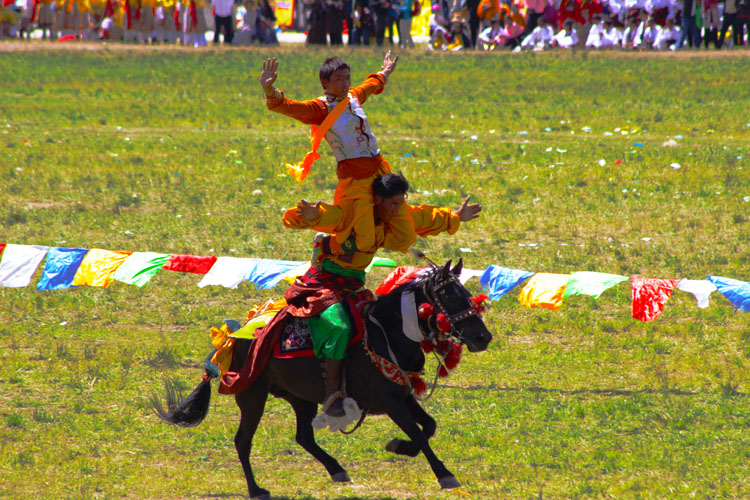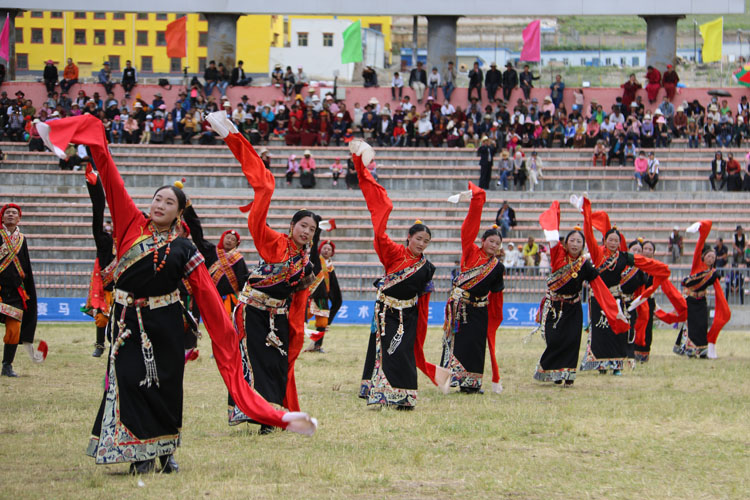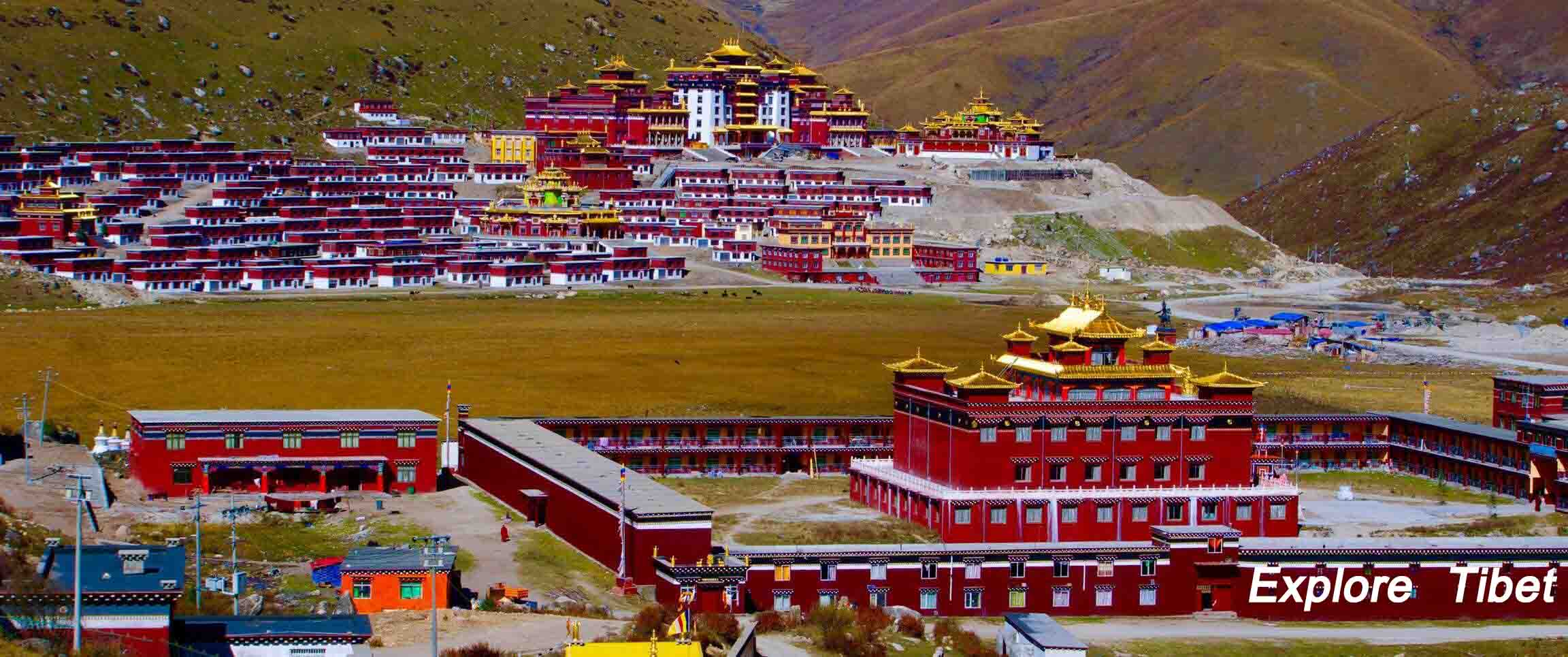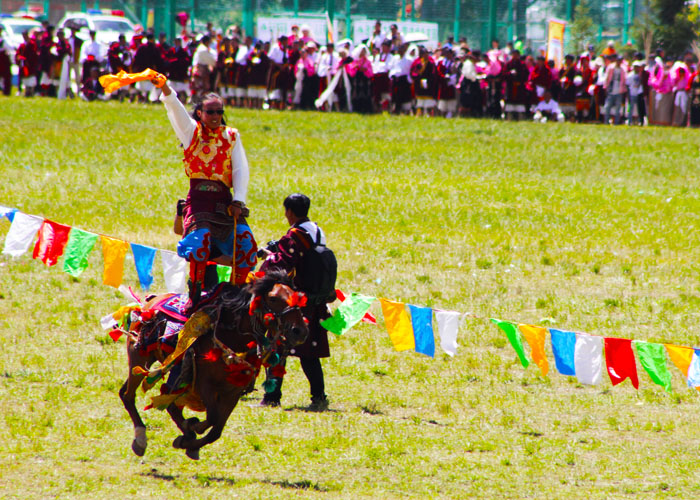
9 Days Yushu Horse Racing Festival Group Tour
A unique tour of the Tibetan area around Yushu in Qinghai Province of northwest China, this amazing tour takes you to visit the famous Yushu Horse Racing Festival on the vast grasslands that extend between the Kunlun and Tanggula Mountain ranges. The most popular horse racing festival in the eastern area of the plateau, the Yushu festival is popular with the Tibetan nomadic herders that live on the plains of southern Qinghai.

Table of Contents
Tour Itinerary
On your arrival in Yushu, we will take a short drive to Jyekundo, the regional capital of the Yushu Tibetan Autonomous Prefecture, and stay overnight in the city. The second and third days are spent at the festival, to give you the chance to make the most of this unique and amazing tour. The festival is not just for horse racing, though that is the main event. You can also find a number of other features at the festival, including traditional Tibetan sports, song and dance performances, Tibetan operas, and costume show competitions for the best dressed horses and riders. Tibetans from all across the ancient Kham region of Tibet come for the festival’s attractions, and Yushu is well known as the cultural center of the Khampa people.
After the festival, you will spend some time traveling to the various other attractions in the area, and on day four, you will leave Jyekundo early to head for Dzachuka (Shiqu) in Sichuan Province, passing by and visiting the famous Sershul Monastery along the way, the largest Gelug monastery in the Kham region. After exploring the area’s attractions for the rest of the day, we will continue the following day, driving to Dzogchen to visit the Shechen Monastery and the Dzogchen Monastery, two of the most important monasteries in the area.

After Dzogchen, we will continue on to Dege in Garzê Tibetan Autonomous Prefecture of Sichuan Province, which is one of the ancient cultural centers of Kham. The route takes you through small villages with ancient monasteries and beautiful stupas, and continues on the following day to reach the Dzongsar Monastery, which you can explore before visiting the local handicrafts center. From Dzongsar, we continue on to Garzê, one of the most delightful small Tibetan towns in Sichuan Province, with its 500-year-old Garzê Monastery.
After Garzê, we move on to Barkham, the capital of the Ngawa Tibetan Qiang Autonomous Prefecture and a modern town with great facilities and a lovely open-air market. The scenery along the route is some of the most beautiful in northwest Sichuan, and after a stop for the night, we will continue on through the stunning landscape to the city of Chengdu, the capital of Sichuan Province and the end of our tour.
Tour Highlights
Yushu Horse Racing Festival
The Yushu Horse Racing Festival is a traditional festival that is normally held at the end of July to the beginning of August, depending on the dates in the Tibetan calendar. The festival site is located in the Yushu Tibetan Autonomous Prefecture of Qinghai Province in northwestern China, and is held on the lush summer grasslands of the valley floor, to make for better horse-racing events. Renowned as being the largest horse racing event in the Tibetan areas, the festival plays host to tens of thousands of Tibetans and tourists every year.
As well as being famed for its daring and awesome feats of horsemanship, and the outstanding races that are done on fast ponies that have been native to the plateau for over two thousand years, the festival has a host of other features as well. Archery on horseback contests are a popular activity to watch, as are the other sporting events, such as tug-of-war, weightlifting, and many other local sports.
You can also enjoy the lighter side of the festival, with songs and dancing performances taking place for the whole period of the festival. Local Tibetan songs that tell of the great deeds of heroes and lamas, as well as stories of the Guru Rinpoche and many other Buddhist saints are wonderful to listen to, and the traditional Tibetan dancing is well choreographed and awesome to watch. There are also traditional Tibetan fashion shows, where women compete wearing the different Tibetan costumes and dress. There is also a prize for the best-dressed horse and rider from the horse racing. Overall, the Yushu Horse racing Festival is one of the most colorful festivals on the plateau.

Dzogchen Monastery
One of the Six Great Monasteries of the Nyingma School of Tibetan Buddhism, Dzogchen Monastery in Dege County was founded in around 1684 by Pema Rigdzin, the first Dzogchen Rinpoche. At its peak, the monastery would hold more than 500 monks, and was in charge of 13 hermitage retreats and around 280 smaller temples. A festive religious gathering at the monastery would have seen tens of thousands of lamas, monks, nuns, and locals.
Dzongsar Monastery
Located in Dege County, Dzongsar Monastery is one of the oldest in modern-day Sichuan, dating back to around 746 AD and the early years of the Tibetan Empire under Songtsen Gampo. The monastery is part of the Sakya School, although it was originally built by a Bonpo lama. Noted for its eclecticism and openness to all branches of Buddhism, the ancient Bon shrine remained a part of the temple until 1958.

Garzê Monastery
Also known as Kandze Monastery, the monastery at Garzê lies on a hilltop overlooking the town and dates back to around 1642. Built by the Khoshut Mongols to overlook their local castles, this amazing monastery once held more than 1,500 Buddhist monks, and was the largest monastery in the Kham area.
Sershul Monastery
The largest Gelug monastery in the Kham region, Sershul Monastery is the only Buddhist Monastic University in the region, and is qualified to teach and bestow the highest of Tibetan Buddhist degrees. The monastery is the religious center of Shiqu County in Garzê, the highest, largest, coldest, and most remote county in Sichuan Province at an altitude of 4,000 meters above sea level. Established in 1701, the monastery stores some of the oldest Buddhist relics, including a block and hammer for penance that dates back to the time of Gautama Buddha himself.
Recent Posts
Exploring the Beauty of Tibetan Handicraft
The Ultimate Guide to Tibet Tours, Travel, and Trekking Adventures
How to Explore Tibetan Culture
All Categories
- About Tibet
- book a Tibet tour
- Buddhism Practice
- Budget Tour
- China-Tibet Train
- Customized Tibet tour
- Historical Sites
- Hot Springs in Tibet
- News
- Photography in Tibet
- Tibet attraction
- Tibet Group Visa
- Tibet Motorcycle Tour
- Tibet Small Group Tours
- Tibet Tours and Tibetan Tour Guide
- Tibet Train
- Tibet Travel FAQs
- Tibet Travel Information
- Tibet Travel News
- Tibet Travel Permit Update
- Tibet Travel Prices Rises
- Tibet Trek
- Tibet Trekking Tour
- Tibet weather and climate
- Tibet Wildlife animals
- Tibet Winter Tour
- Tibetan Buddhism
- Tibetan Cultural Features
- Tibetan Culture and Poeple
- Tibetan Festivals
- What to see in Tibet



